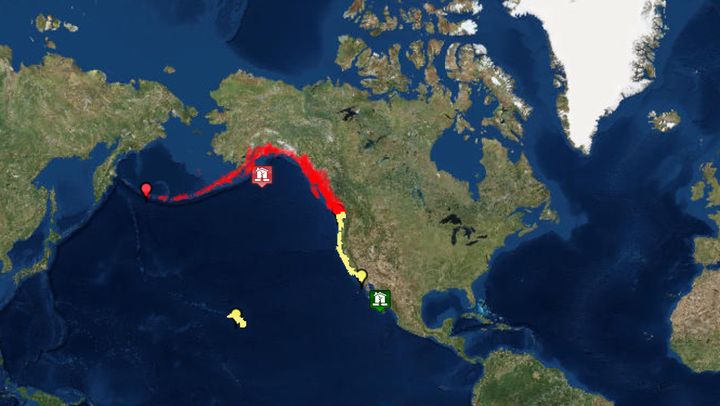A tsunami warning has been lifted hours after a 7.9 magnitude earthquake struck the Gulf of Alaska on Tuesday, sparking evacuations in the US.
A tsunami alert was issued for the US West Coast after the quake hit 256km southeast of Chiniak, Alaska, at a depth of 10km at 9.31am (GMT).
Tsunami waves of less than 1ft had been confirmed, according to the US National Weather Service (NWS).

Emergency sirens sounded in Kodiak, Alaska, after the initial alert was issued.
Kodiak, one of the closest settlements to the epicentre, has a population of 6,100 people.
“This is a tsunami warning. This is not a drill. Please get out to higher ground,” said the announcer on local public radio station KMXT. “If you are on the flats, get up on one of the hills ... Just go high.”
In Alaska, people packed into high schools and other evacuation centres.
“People are fine,” said Neil Hecht, assistant principal of Kodiak High School, which was sheltering a few hundred people. “Spirits are high. Everyone is doing well here,” Reuters reports.
Long lines of traffic formed in coastal communities including Homer and Seward, Alaska, residents warned on social media.
In Homer, a few hundred cars were packed into its high school parking lot. Shawn Biessel, a 32-year-old park ranger, and his mother were in the lot, a few hundred feet above sea level.
“It was a really obvious, pretty strong, long quake. A good rumbler,” Biessel said in a phone interview. “It went on for a solid minute and after a while we thought we should get outside.”
Police drove through Biessel’s neighborhood with flashing lights to alert residents to evacuate, Biessel said.
“Please heed local warnings to move inland or to higher ground,” Alaska Governor Bill Walker said in a statement.
Kodiak Police Department posted a video to Facebook urging residents to evacuate their homes and to move to ground at least 100ft or higher.
The tsunami advisory remained in place until 3.12am local time (12.12pm GMT).
The earthquake was previously measured at magnitude 8.2.
Emily Carlson, who lives in Anchorage, Alaska, which is not in the tsunami alert zone, told Sky News that she and her husband felt the earthquake for about 30 seconds.
A weatherman in the US tweeted a graphic of a buoy which recorded a wave of 32ft shortly after the earthquake hit.
Officials had warned residents as far south as San Francisco to be ready to evacuate coastal areas but later lifted tsunami watches for California, Oregon and Washington states as well as coastal British Colombia in Canada.
An initial tsunami watch for Hawaii was cancelled.
In the immediate aftermath of the quake, the Pacific Tsunami Warning Center said that data suggested the tsunami “could be destructive on coastal areas even far from the epicenter”.
Alaskan residents are not unused to earthquakes. The northern US state has recorded 11 tremors with a magnitude of 7 or greater within 373 miles (600 km) of Tuesday’s quake over the past century, according to Zachary Reeves, a USGS seismologist in Golden, Colorado.
The largest US earthquake ever recorded was a magnitude-9.2 temblor in Alaska in March 1964, causing tidal waves of more than 100 feet (30 m) high that killed 131 people.
Japan’s meteorological agency said it was monitoring the situation but did not issue a tsunami alert.
